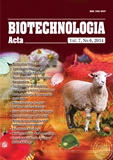ISSN 2410-7751 (Print)
ISSN 2410-776X (Online)

"Biotechnologia Acta" v. 7, no 6, 2014
https://doi.org/10.15407/biotech7.06.040
Р. 40-45, Bibliography 14, Ukrainian
Universal Decimal classification: 612.398:577.121.3
GENE 16S RRNA SEQUENCE PHYLOGENETIC ANALYSIS OF LYSINE PRODUCERS STRAINS
G. S. Andriiash1, G. M. Zabolotna1, V. S. Bondarenko2, S. M. Shulga1
1State organization «Institute of Food Biotechnology and Genomics» of the National Academy of Sciences of Ukraine, Kyiv
2SEC «Institute of Biology» of Taras Shevchenko Kyiv National University, Ukraine
The phylogenetic relationships of strainsproducers of essential amino acids of aspartate family Brevibacterium sp. UCM Ac-674 (Brevibacterium sp. 90), Brevibacterium sp. IMV Ac-5004 (Brevibacterium sp. 90H), Brevibacterium sp. UCM Ac-675 (Brevibacterium sp. E531), mutant strain Brevibacterium sp. IMV B-7447 from the «Collections strains and lines of plants for food and agricultural biotechnology SO “Institute for Food Biotechnology and Genomics” of National Academy of Sciences of Ukraine were investigated. The affiliation strain Brevibacterium sp. IMV B-7447 to the genus Brevibacterium within the sequences of the genes based on 16S rRNA was confirmed.
The dendogram of phylogenetic relationships of studied strains and related strains Brevibacterium from database GenBank was constructed. It was shown that by the criterion of homology gene sequences based on 16S rRNA the investigated strains-producers belong to three phylogenetic groups.
It was established that the mutant strain Brevibacterium sp. ІMV B-7447 has no analogues in the database GenBank.
Key words: Brevibacterium, gene 16S rRNA.
© Palladin Institute of Biochemistry of the National Academy of Sciences of Ukraine, 2014
References
1. Andriiash G. S., Zabolotna G. M., Shulga S. M. Regulation and intensification ways of lysine biosynthesis. Mikrobiologiia ta biotekhnologiia. 2012, V. 4, P. 6–17 (In Ukrainian).
2. Andriiash G. S., Zabolotna G. M., Shulga S. M. Auxotrophity of producers of lysine Brevibacterium sp. Biotekhnologiia. 2012, 1 (4), 70–77 (In Ukrainian).
3. Borshchevskaya L. N., Kalinina A. N., Sineokii S. P. Design of a PCR-test based on the gyrA gene sequence for identification of closely relative species of the Bacillus subtilis group. Biotekhnologiia. 2012, V. 3, P. 32–43 (In Russian).
4. Andriiash G. S., Zabolotna G. M., Shulga S. M. The mutant strains of microorganisms — producers of lysine and threonine. Biotechnologia Acta. 2014, 3 (7), 95–101.
http://dx.doi.org/10.15407/biotech7.03.095
5. GenBank (Base sequences of DNA) URL: http://blast.ncbi.nlm.nih.gov
6. Wilson K. Preparation of Genomic DNA from bacteria. Current protocol in Molecular biology. 2001, 2.4.1–2.4.5.
7. Fedorenko V., Ostash B., Rebets Y.,Gonchar M. Large workshop on genetics, genetic engineering and biotechnology analysis of microorganisms. Lviv. 2006, P. 185–188, 193–196. (In Ukrainian).
8. Martinenko O. I. Methods of molecular biotechnology: Laboratory workshop. Kyiv. 2010, P. 212–215, 221–223 (In Ukrainian).
9. Edwards K. Real-time PCR: An essential guide. K. Edwards, Logan J., Sauders N., Wymondham. Horizon Bioscience. 2004, 346 p.
10. Melnichuk M. D. Biotechnology of plants. D. Melnichuk, T. V. Novak, V. A. Kunach. Kyiv: Poli graphconsalting. 2003, 520 p.
11. Guttel R., Larsen N., Woese C. Lessons from an evolving rRNA:16S and 23S rRNA structures from a comparative perspective. Microbiol. Rev. 1994, 8 (1), 10–24.
12. Thompson J. D., Higgins D. G., Gibson T. J. CLUSTAL W: improving the sensitivity of progressive multiple sequence alignment through sequence weighting, position-specific gap penalties and weight matrix choice. Nucleic Acids Res. 1994, 22 (22), 4673–4680.
http://dx.doi.org/10.1093/nar/22.22.4673
13. Tamura K., Nei M. Estimation of the number of nucleotide substitutions in the control region of mitochondrial DNA in humans and chimpanzees. Mol. Biol. Evol. 1993, V. 10, P. 512–526.
14. Tamura K., Stecher G., Peterson D., Filipski A., Kumar S. MEGA6: Molecular Evolutionary Genetics Analysis version 6.0. Mol. Biol. Evol. 2013, V. 30, P. 2725–2729.
http://dx.doi.org/10.1093/molbev/mst197

